#kashmir sufis
Explore tagged Tumblr posts
Text
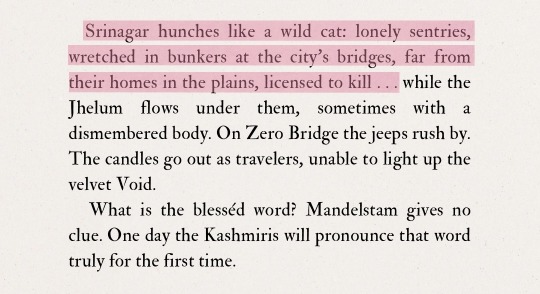
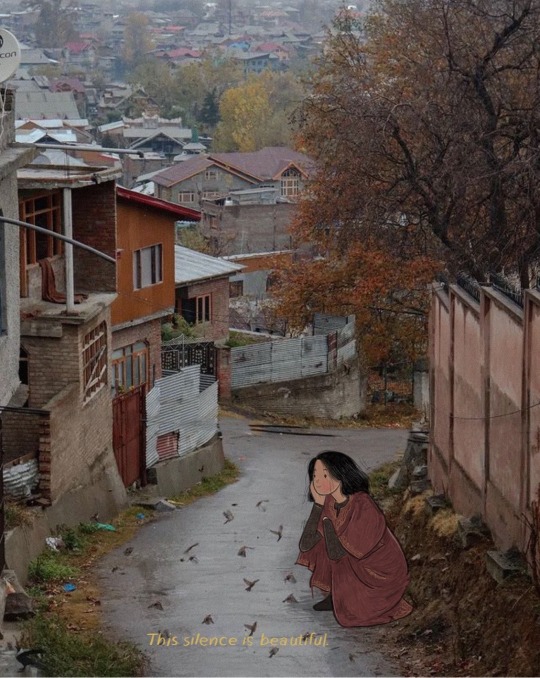

— Agha Shahid Ali, from The Country Without a Post Office // art by Ghazal Qadri (photographed by Zainab Mufti) // Couplet by Amir Khusro
#kashmir#agha shahid ali#ghazal qadri#amir khusro#jehangir#desi academia#dark academia#poetry#kashmiri poetry#paradise on earth#art#desi art#light academia#translation#inquilab zindabad#sufism#sufi#persian#farsi#sufi poetry#booklr#books#book quotes
34 notes
·
View notes
Text
The Martand Sun Temple, Kashmir
Dedicated to Lord Surya, Hinduism's principal sun god; Surya Dev is also recognized through his Sanskrit name Martand.
It was made by King Lalitaditya in around 5th Century A.D. and it was destructed by Muslim ruler Sikander Butshikan, under the advice of Sufi preacher Mir Muhammad Hamadani. It is believed that the was so strongly built that it took many days for its destruction.
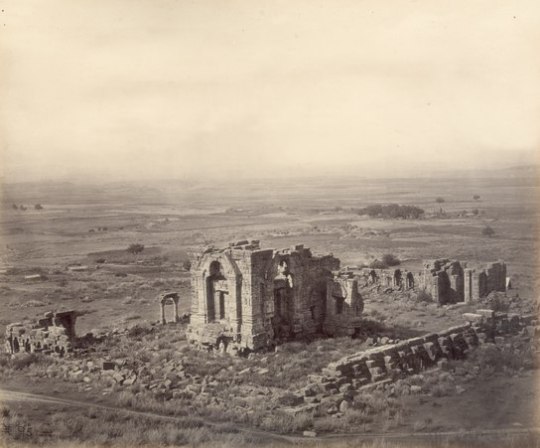
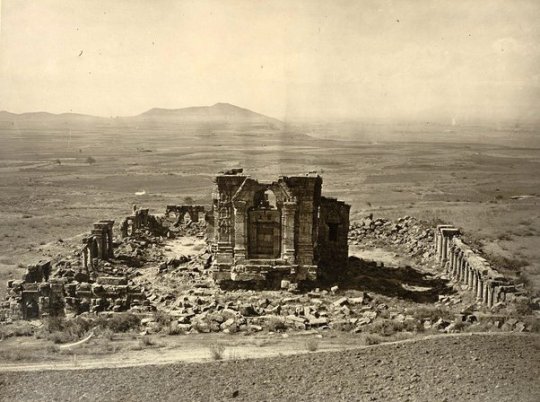


The temple has a colonnaded courtyard, with its primary shrine in its center and surrounded by 84 smaller shrines, stretching to be 220 feet long and 142 feet broad total and incorporating a smaller temple that was previously built.
The primary shrine is located in a centralised structure (the temple proper) that is thought to have had a pyramidal top - a common feature of the temples in Kashmir. Various wall carvings in the antechamber of the temple proper depict other gods, such as Vishnu Ji and river goddesses, such as Mata Ganga and Mata Yamuna, in addition to the sun-god Surya Dev.
How it must’ve looked ->

#sun temple#mughal invasion#hindublr#hinduism#sanatan dharma#bharat#ancient india#india#kashmir#hindu temples#hindu culture#hindu architecture#indian architecture#lalitaditya#sufi#islamic terrorism#kashmiri hindus
50 notes
·
View notes
Text
Selections from the Mystic Poetry of Lalla of Kashmir
Restless mind, don’t infect the heart with fear. That virus is not for you. The Infinite knows what you hunger for. Ask Him to carry you across.
Some, who have closed their eyes, are wide awake. Some, who look out at the world, are fast asleep. Some who bathe in sacred pools remain dirty. Some are at home in the world but keep their hands clean.
Good or bad, I’m happy to welcome both. I don’t hear with my ears, I don’t see with my eyes. A voice speaks inside my heart, my jewel-lamp burns bright even in a rampaging wind.
Lord! I’ve never known who I really am, or You. I threw my love away on this lousy carcass and never figured it out: You’re me, I’m You. All I ever did was doubt: Who am I? Who are You?
Wrapped up in Yourself, You hid from me. All day I looked for You and when I found You hiding inside me, I ran wild, playing now me, now You.
Don’t flail about like a man wearing a blindfold. Believe me, He’s in here. Come in and see for yourself. You’ll stop hunting for Him all over.
A thousand times at least I asked my Guru to give Nothingness a name. Then I gave up. What name can you give to the source from which all names have sprung?
Who trusts his Master’s word and controls the mind-horse with the reins of wisdom, he shall not die, he shall not be killed.
Those who glow with the light of the Self are freed from life even while they live. But fools add knots by the hundred to the tangled net of the world.
When the dirt was wiped away from my mind’s mirror, people knew me for a lover of God. When I saw Him there, so close to me, He was All, I was nothing.
I trapped my breath in the bellows of my throat: a lamp blazed up inside, showed me who I really was. I crossed the darkness holding fast to that lamp, scattering its light-seeds around me as I went.
Alone, I crossed the Field of Emptiness, dropping my reason and my senses. I stumbled on my own secret there and flowered, a lotus rising from a marsh.
My mind boomed with the sound of Om, my body was a burning coal. Six roads brought me to a seventh, that’s how Lalla reached the Field of Light.
You rule the earth, breathe life into the five elements. All creation throbs with the Unstruck Sound. Immeasurable, who can take Your measure?
He who strikes the Unstruck Sound, calls space his body and emptiness his home, who has neither name nor colour nor family nor form, who, meditating on Himself, is both Source and Sound, is the god who shall mount and ride this horse.
He knows the crown is the temple of Self. His breath is deepened by the Unstruck Sound. He has freed himself from the prison of delusion. He knows he is God, who shall He worship?
Master, leave these palm leaves and birch barks to parrots who recite the name of God in a cage. Good luck, I say, to those who think they’ve read the scriptures. The greatest scripture is the one that’s playing in my head.
What the books taught me, I’ve practiced. What they didn’t teach me, I’ve taught myself. I’ve gone into the forest and wrestled with the lion. I didn’t get this far by teaching one thing and doing another.
I gave myself to Him, body and soul, became a bell that the clear note of Him rang through. Thoughts fixed on Him, I flew through the sky and unlocked the mysteries of heaven and hell.
Wear the robe of wisdom, brand Lalla’s words on your heart, lose yourself in the soul’s light, you too shall be free.
-- I, LALLA The Poems of Lal Ded Translated from the Kashmiri by Ranjit Hoskote
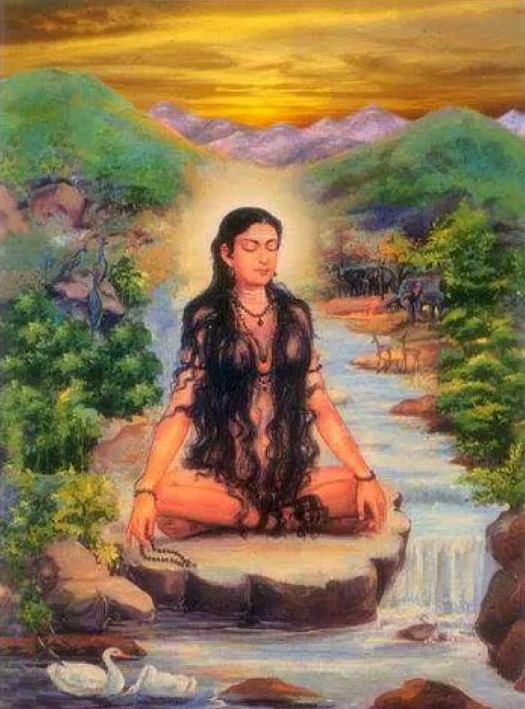
#lalla#kashmir#kashmir shaivism#communion with God#meditation#spirituality#mystics#poetry#sants#sufis
33 notes
·
View notes
Text




The aesthetics of Khanqah-e-Moula>
-Srinagar, Kashmir.
9 notes
·
View notes
Text
A Sage of 17th Century: Hazrat Shah Asrar ud Din Baghdadi (RA): Sadaket malik
Hazrat Shah Asrar-ud-Din’s impact on the spread of Islam was profound. His active involvement in preaching and supporting his father, Shah Mohd. Asrar-ud-Din, demonstrated a deep sense of responsibility and a commitment to sharing the teachings of Islam with the wider community. Kishtwar – which has a history of communal tensions that have turned deadly in the past – the shrine of Shah Asrar, a…
#khanqah i asrariya kishtwar#qadri saint of kashmir#saints of kistwar#shah asraruddin qadri#sufis of kishtwar
0 notes
Text
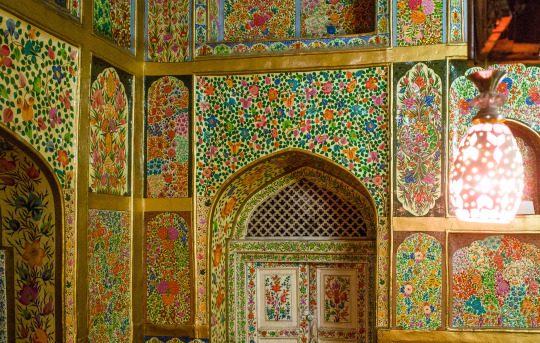
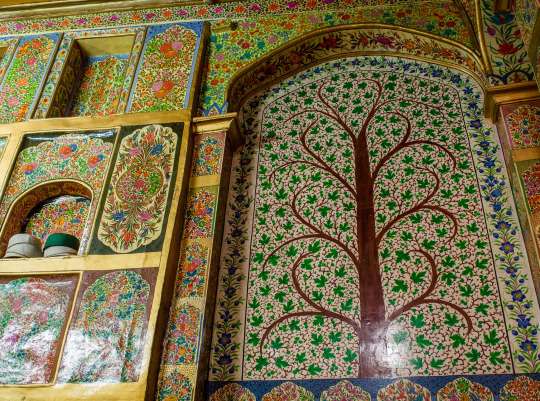
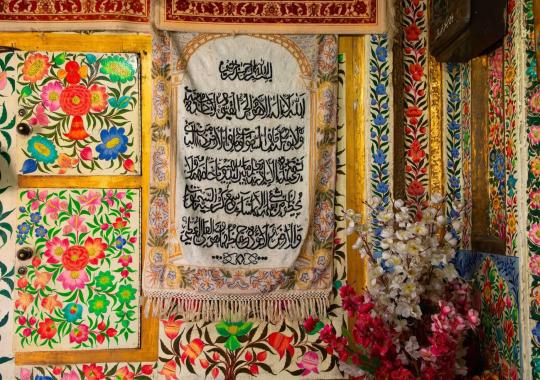
the papier-mache walls of the shrine in kanqah naqshband sahib in srinagar, kashmir, built in its current form in 1633. the complex is dedicated to bukharan baha' al-din naqshband, who founded the naqshbandi sufi order, and is a mausoleum for one of his descendants. the shrine is a site for ziyarat as it contains what's said to be a lock of the prophet muhammad's hair.
#kashmir#interior#details#worship#muslim#nmenam#papier-mache kashmir#religious tombs#my posts#i forgot to mention in my post on kanqah-e-moula that papier-mache was brought over to kashmir by the same guy who brought#over islam. which is why papier-mache walls in kashmir are in muslim places of worship a lot#of the time. and also in iran and central/northern south asia there's some papier-mache decals on muslim places of worship too iirc#but the papier-mache is mostly on items because it's easier to do it on items than whole walls#kashmir is well-known for papier-mache stuff#the fancy technical term is ''lacquerwork'' but i already used papier-mache so
237 notes
·
View notes
Text

A Kashmiri Muslim woman prays as a relic of Sufi saint Sheikh Syed Abdul Qadir Jeelani is displayed outside his shrine in Srinagar, Indian controlled Kashmir, Friday, Oct. 18, 2024. (AP Photo/Dar Yasin)
7 notes
·
View notes
Note
Less of an answer to your original question, more of an interesting anecdote, but there is an interesting dialogue of religious poetry between Islam and Hinduism in South Asia. Sufis and Shaivists especially would imitate one another. Lal Ded is celebrated by both religions in Kashmir, for example. The Hindu Vatsun style is likely taken from the Muslim Ghazal style. Just kinda neat I think.
this is neat, thanks!
5 notes
·
View notes
Note
okay I have to vent, you can ignore this ask but I would love it if you gave your opinions on the topic. Hindublr lately seems to be filled with spam tagged #casteism and other things wherein the entire religion or culture is reduced to just caste atrocities. I blocked some but it is like new accounts spring up everyday. Hindublr isn't a politics tag? Atleast it wasn't when I first joined tumblr. Also these blogs are full of blatant hindu hate and somehow they equate being an orthodox hindu as being a bjp supporter? Like if you call them out on their misinformation they start calling you andhbhakt even if the context had nothing to do with bjp? Modi hate or Yogi hate is so blatant. Like these blogs aren't even talking about actual problems. They spread misinformation most of the times. Like yk in one of your answers on that one blog that was regarding Congress sending army to kashmir.
Half baked knowledge, "saviour of the dalits" complex and Hindu hate is all they offer. I am all for talking about genuine discrimination that goes on in our society but it must be based on facts rather than artificial hysteria and emotion driven ideologies.
Honestly, call me a hypocrite because I use the hindublr tag for political stuff relating to hindus aswell , but I will admit that the tag of Hindublr is not for Hindu hate, its for hindus to engage.
Blogs like not-so-sweet61 and others following her trail are truly going out of their way to spread hate about us. Their motive for tagging is not to spread awareness, because their manner of presenting is vehemently anti Hindu (as you said, half baked facts) , and what they do is not spreading awareness either; they are doing a sham act of defaming the religion in the name of “calling out the bad practices” by bringingthe character of Shri Ram and others into question.
And before people call me out for being a propagandist and all, the sweet61 is not someone who is calling out ill treatment of Dalits that I am too much of an andhbhakt to see, this person is a muslim calling out Hindu Gods. I had an altercation with her during the infancy of this blog, and skimmed through hers to find Sufi quotations and other Islam related stuff that has most likely been removed as of now becuase I can no longer find it.
That put things in perispective for y’all?
Also, cherry on the cake, she’s a congressi, girl legit quoted Sonia Gandhi on section 377 like it was not Congress under whose command it was reinstated🤡 So yeah, ofcourse theres andhbhakt comments and equating shit to BJP.
They are not saviours of dalits, they are not champions of minority. These are people of other faiths targetting us systematically, maybe because of the non left alignment of people who use the hindublr tag.
And another thing? Hindublr tag is used by Hindus ourselves, like I said, for engaging with each other on religion related stuff. For those not of the faith, they use hinduism tag. The specific use is for us so these people are using the tag on purpose to get our attention.
Nothing more, nothing else.
17 notes
·
View notes
Text

Day 20: Lalleshwari!
Lalleshwari, also known as Lal Ded, was born in the early 1300s in the Kashmir Valley; not much is known of her family, but they are generally held to have been high-caste Brahmins. She was married young, but her marriage was deeply unhappy, and in her twenties she fled the abuse for a more spiritual life.
She became the disciple of a wandering Shaivite teacher, and eventually took up the mantle of a religious leader herself - walking from town to town, giving up material possessions, and, in Lalleshwari's case, composing religious poetry.
The Kashmiri language as we know it today emerged in the 1300s, and Lalleshwari's 285 vakhs, some of its earliest known poems, helped codify it as a literary tongue. Her work - and her teachings - took influence from mulitiple faiths and cultures and spread beyond Shaivite Hindus; the Sufi saint Nund Rishi counted her as one of his teachers.
She is revered in modern Kashmir, both for her philosophy and her poetry.
#lalleshwari#lal ded#kashmiri history#indian history#history#awesome ladies of history#october 2023#my art#digital art#brush credits to firealpaca
6 notes
·
View notes
Audio
Electric Sufi - Breathe In Love
This is Breathe in Love, the new album by Electric Sufi. A first single 'O Ignis Spiritus' will be released on 1 February 2023, the album will be released later that year.
Electric Sufi are Sheffield based Professor of Music and Sound Archaeologist at Huddersfield University Rupert Till, Manchester based singer-songwriter and environmental activist Sarah Yaseen and Nottingham based multi-instrumentalist / University lecturer Mina Mikhael Salama.
Rupert has produced ambient dance, chillout and electronic music under the the moniker Professor Chill throughout his career, including the album Dub Archaeology released in 2018. He’s also written the book Pop Cult which delves into the mysteries of music and spirituality, participated in the BBC TV series Civilisations as well as numerous other TV and radio shows, plus written articles in The Quietus, Huffington Post and New Scientist. His extensive research projects have been wide and varied, covering a multitude of subjects ranging from ‘The influences of Religion on British Club Culture and Electronic Dance music’ to ‘Sound Archaeology, Acoustics and Cave Art’.
Sarah, whose family roots are in Kashmir, is known in world music circles as a singer in UK Womad favourites Rafiki Jazz and Danish all-woman ensemble Radiant Arcadia. In Electric Sufi she sings in Urdu, Punjabi, Persian, Latin and English – and by doing so, draws upon a wide range of cultural influences. Inspired by Qawwali (Islamic devotional singing from India) and Ghazals (Arabic poetry), she has one foot firmly placed in a contemporary multicultural world and the other in the ancient lyrical and musical traditions on which she draws.
Mina, a Coptic Christian from Alexandria, Egypt, came to the UK as a refugee, taking asylum here from persecution in his homeland. He has since contributed much to UK culture through his performances at WOMAD, Edinburgh Festival, The Southbank, London as well as Cardiff, Leicester, Manchester and beyond. Along with Rupert, Mina has also contributed to the BBC TV series Civilisations where he demonstrated a 30,000-year-old Isturitz Vulture bone flute. On an international level, Mina has contributed to the music score on Disney’s Aladdin, directed by Guy Richie and starring Will Smith, Mena Massoud and Naomi Scott.
With a first performance at Bradford’s Kala Sangam Arts Centre, which received much applause from a diverse audience, this trio brings much collectively and individually to the Electric Sufi sound, resulting in a rich tapestry of cultural and musical layers of influence that their album Breathe In Love explores in much detail. Their modern interpretation of O Ignis Spiritus is a wonderful introduction to this enchanted world and their message of hope.
3 notes
·
View notes
Text
The Musical Legacy of Jab Tak Hai Jaan
Released in 2012, Jab Tak Hai Jaan holds a special place in Bollywood history, being the final film directed by the legendary Yash Chopra. Known as the "King of Romance," Chopra created a timeless cinematic style rooted in love, beauty, and deep emotional resonance. His partnership with A.R. Rahman, one of India's most celebrated music composers, brought a fresh, contemporary sound to the film's soundtrack, while lyricist Gulzar added his poetic touch. Together, they crafted songs that elevated Jab Tak Hai Jaan into a beautiful blend of melody, emotion, and cinematic beauty. It’s a soundtrack we often share on Ruh Radio 1440 AM, where timeless melodies like these find a home and continue to touch listeners' hearts.

Let’s take a closer look at each song and what makes this album unforgettable.
1. "Challa"
"Challa" is the album’s first track and one of the most popular songs. Sung by Rabbi Shergill, known for his Sufi-influenced style, the song features Shah Rukh Khan wandering the streets of London, strumming his guitar as he reflects on life, love, and destiny. The lyrics by Gulzar are introspective, full of a sense of wonder, as Challa (meaning "wanderer") searches for a place to belong. A.R. Rahman’s composition infuses the track with a contemporary folk vibe that captures the loneliness and mystery of a person trying to find his purpose in life.
2. "Saans"
"Saans" is the heart of Jab Tak Hai Jaan's love story, often considered one of the most sensual and romantic songs in Bollywood. Sung by Shreya Ghoshal and Mohit Chauhan, the song captures the essence of longing and the euphoria of being close to someone you love. Rahman’s orchestration here is lush and evocative, blending strings with piano to create a soft yet intense backdrop for the vocals. Gulzar's lyrics describe the ache of separation and the relief of reuniting, with the line "Saans mein teri saans mili toh mujhe saans aayi" ("I breathed only when I breathed in your breath") becoming particularly iconic. The song, featured on Katrina Kaif and Shah Rukh Khan, is beautifully shot and choreographed, capturing the simmering intensity between the two characters.
3. "Ishq Shava"
This upbeat, fast-paced song adds a burst of energy to the album. Sung by Shilpa Rao and Raghav Mathur, "Ishq Shava" captures the excitement and daring of young love, with Shah Rukh Khan and Katrina Kaif dancing through a fiery, high-energy sequence in a London nightclub. Rahman’s composition combines Arabic influences with modern beats, creating a lively and catchy track that’s perfect for a dance number. The lyrics reflect the thrill of surrendering to love, daring to live in the moment, and letting go of inhibitions. "Ishq Shava" stands out for its playful yet passionate appeal and is remembered for its unique choreography and dynamic visuals.
4. "Heer"
One of the most soulful and poignant songs in the album, "Heer" is inspired by the tragic love story of Heer-Ranjha from Punjabi folklore. Sung beautifully by Harshdeep Kaur, the song is a traditional Punjabi folk melody that captures the timeless, melancholy nature of true love. Gulzar’s lyrics draw on the sorrow and endurance of Heer’s character, who pines for her lost love. The song resonates with deep emotions, and Rahman’s arrangement keeps the melody simple yet haunting, emphasizing the powerful vocals. "Heer" reflects the deep-rooted pain and yearning that underline the love story in Jab Tak Hai Jaan, resonating with anyone who has experienced unfulfilled love.
5. "Jiya Re"
In stark contrast to the melancholic tone of "Heer," "Jiya Re" is an exuberant and liberating track that celebrates life. Sung by Neeti Mohan, this song represents Anushka Sharma’s character Akira, an adventurous, carefree woman who lives life to the fullest. The track is set in Kashmir and showcases Akira’s vivacious spirit, capturing her joy and love for life. A.R. Rahman adds a blend of Indian and Western beats to create a peppy, upbeat song that is refreshing and inspiring. "Jiya Re" stands out for its energy and represents the idea of living every moment without fear.
6. "Jab Tak Hai Jaan" (Poem Recitations)
In addition to the main songs, the film also features poetic recitations by Shah Rukh Khan that express the core philosophy of the film. The verses, written by Gulzar, are intense, raw, and passionate, capturing the essence of a love that defies time, logic, and even life itself. These recitations are not just poetic interludes but pivotal moments that deepen the film's emotional intensity, bringing out the vulnerability and passion in Khan's character. They resonate deeply with the theme of undying love, the main motif that runs through Jab Tak Hai Jaan.
7. "Jab Tak Hai Jaan" (Title Track)
The title track, "Jab Tak Hai Jaan," sung by Javed Ali and Shakthisree Gopalan, is a soft, melodious expression of devotion and loyalty in love. The music flows like a gentle river, with a haunting rhythm that mirrors the eternal, self-sacrificing nature of love that underpins the movie. Rahman’s minimalist approach here, with soft background instrumentation, allows the lyrics to shine. It serves as a fitting closure to the album, leaving a lasting impression of timeless love.
Conclusion
The Jab Tak Hai Jaan soundtrack is an emotional journey through the many shades of love, from euphoria to longing, independence to devotion. With A.R. Rahman’s versatile compositions, Gulzar’s poetic lyrics, and memorable performances by the singers, the album continues to resonate with audiences. Tracks like these make Jab Tak Hai Jaan a soundtrack we’re proud to share on Ruh Radio 1440 AM—where timeless music finds new listeners every day. It is a fitting tribute to Yash Chopra's legacy—a testament to his vision of love that transcends time, lives, and even death. Through this album, Jab Tak Hai Jaan remains not just a film but a soulful musical experience, immortalizing Yash Chopra's love for romance and for cinema.
Do follow us on Instagram and Facebook.
0 notes
Text
Lal Ded: The Mystic Poet of Kashmir
English Version:

Lal Ded, also known as Lalleshwari, is one of the most revered mystic poets of Kashmir. Born in the 14th century, Lal Ded's life and work have had an enduring impact on Kashmiri culture, spirituality, and literature. She is regarded as a saint, a spiritual guide, and an iconic figure whose poetry transcends time and place. Known for her deep spirituality and profound insights into life, Lal Ded’s verses reflect a fusion of mysticism, devotion, and social consciousness.
Life and Legacy
Lal Ded was born into a Kashmiri Pandit family in the village of Pandrethan, near Srinagar, in Kashmir. Her early life was marked by personal suffering, which often inspired the themes in her poetry. She was married at a young age, but her marriage was not a happy one. After facing emotional and spiritual turmoil, Lal Ded left her family and began wandering, seeking solace in the natural world and in spiritual practices.
It is said that Lal Ded was greatly influenced by the teachings of the Sufi mystics who came to Kashmir during the 14th century. The Sufi tradition of Kashmir blended Islamic mysticism with the region’s Hindu philosophy, and this fusion is clearly reflected in Lal Ded's poetry. She began writing verses known as "Lal Vakhs", which were written in the Kashmiri language and conveyed the deepest truths about human existence, the nature of the divine, and the pursuit of spiritual enlightenment.
Themes of Lal Ded's Poetry
Lal Ded's poetry primarily focuses on themes such as:
Self-realization and Spiritual Liberation: Lal Ded's verses emphasize the importance of seeking truth within oneself. She encourages individuals to transcend outward rituals and material attachments and to look inward for spiritual enlightenment.
The Unity of God: Her poems reflect a deep understanding of the oneness of God. In her view, the divine is present in everything, and true spirituality involves experiencing this unity through love, devotion, and self-awareness.
Rejection of Superficial Rituals: Lal Ded was critical of ritualistic practices and dogma that often overshadow true spiritual growth. Her poems encourage people to break free from the constraints of formal religion and connect with the divine on a personal level.
Love and Compassion: Love, both for the divine and for fellow human beings, is central to Lal Ded’s teachings. Her poetry often speaks of divine love as a force that transcends religious differences and brings all souls together.
Lal Ded’s Influence

Lal Ded’s impact on Kashmiri culture and spiritual life is immeasurable. Her poetry, which was passed down orally for generations, forms an integral part of Kashmiri folk culture. The mystic poet's works were an essential part of the Bhakti movement in India, which sought to unite people through love and devotion to God, beyond the confines of caste, religion, and ritual.
Even today, her verses are recited by Kashmiri Pandits and Muslims alike, demonstrating the universality of her teachings. Her philosophy also resonates with contemporary movements that promote tolerance, love, and spiritual awakening.
Lal Ded's poetry remains a source of inspiration for people across the world. Her verses have not only enriched the spiritual landscape of Kashmir but have also offered profound insights into the universal human quest for meaning, truth, and inner peace. She is remembered not only for her literary brilliance but for her deep devotion and her unwavering commitment to the search for spiritual truth.
Hindi Version:
लाल देद: कश्मीर की रहस्यमयी कवि
लाल देद, जिन्हें Lalleshwari के नाम से भी जाना जाता है, कश्मीर की सबसे प्रतिष्ठित रहस्यमयी कवियों में से एक हैं। 14वीं सदी में जन्मी, लाल देद का जीवन और उनके काव्य ने कश्मीरी संस्कृति, आध्यात्मिकता और साहित्य पर गहरा प्रभाव डाला है। उन्हें एक संत, एक आध्यात्मिक मार्गदर्शक और एक प्रतीकात्मक व्यक्तित्व के रूप में पूजा जाता है, जिनकी कविताएँ समय और स्थान की सीमाओं को पार करती हैं। अपनी गहरी आध्यात्मिकता और जीवन के प्रति गहरे दृष्टिकोण के लिए प्रसिद्ध, लाल देद की कविताएँ रहस्यवाद, भक्ति और सामाजिक चेतना का अद्भुत मिश्रण प्रस्तुत करती हैं।
जीवन और धरोहर
लाल देद का जन्म कश्मीर के श्रीनगर के पास पंद्रेथन गाँव में एक कश्मीरी पंडित परिवार में हुआ था। उनके जीवन की शुरुआत व्यक्तिगत कष्टों से भरी थी, जो अक्सर उनकी कविताओं के विषय बने। उनका विवाह बचपन में हुआ था, लेकिन उनका वैवाहिक जीवन सुखद नहीं था। व्यक्तिगत और आध्यात्मिक संकटों का सामना करने के बाद, लाल देद ने अपने परिवार को छोड़ दिया और आत्म-साक्षात्कार के लिए भटकने लगीं।
कहा जाता है कि लाल देद पर 14वीं सदी में कश्मीर में आए सूफी रहस्यमियों का गहरा प्रभाव था। कश्मीर के सूफी परंपरा ने इस्लामी रहस्यवाद और हिंदू दर्शन का अद्भुत मिलाजुला रूप प्रस���तुत किया, जो स्पष्ट रूप से लाल देद की कविताओं में दिखता है। उन्होंने अपनी कविताओं को कश्मीरी भाषा में लिखा, जिन्हें "लाल वाख" कहा जाता है, और इन कविताओं में मानव जीवन, ईश्वर के स्वभाव और आध्यात्मिक मुक्ति के प्रति गहरी सच्चाईयाँ व्यक्त की गईं।
लाल देद की कविताओं के प्रमुख विषय
लाल देद की कविताओं में मुख्य रूप से निम्नलिखित विषय होते हैं:
आत्म-साक्षात्कार और आध्यात्मिक मुक्ति: लाल देद की कविताएँ आत्मा के भीतर सत्य की खोज पर जोर देती हैं। वे लोगों को बाहरी अनुष्ठानों और भौतिक बंधनों से ऊपर उठकर आत्म-ज्ञान और आध्यात्मिक जागृति की दिशा में बढ़ने का मार्गदर्शन करती हैं।
ईश्वर की एकता: उनकी कविताओं में ईश्वर की एकता का गहरा दर्शन है। उनके अनुसार, ईश्वर हर वस्तु में विद्यमान है, और सच्ची आध्यात्मिकता का अर्थ है इस एकता का अनुभव करना।
सांस्कृतिक और धार्मिक कर्मकांडों का परित्याग: लाल देद ने धार्मिक कर्मकांडों और रूढ़िवादिता की आलोचना की, जो अक्सर सच्ची आध्यात्मिक प्रगति में अवरोध उत्पन्न करते हैं। उनकी कविताएँ लोगों को पारंपरिक धार्मिक सीमाओं से ऊपर उठकर ईश्वर से व्यक्तिगत जुड़ाव की आवश्यकता की बात करती हैं।
प्रेम और करुणा: लाल देद की कविताओं में प्रेम, खासकर ईश्वर के प्रति और मानवता के प्रति प्रेम, का प्रमुख स्थान है। वे प्रेम को एक ऐसी शक्ति मानती हैं जो धार्मिक भेदभावों को पार करती है और सभी आत्माओं को एकजुट करती है।
लाल देद का प्रभाव
लाल देद का कश्मीरी संस्कृति और आध्यात्मिक जीवन पर अनमोल प्रभाव पड़ा है। उनकी कविताएँ, जो पीढ़ी दर पीढ़ी मौखिक रूप से传 की गईं, कश्मीरी लोकसंस्कृति का अभिन्न हिस्सा बन चुकी हैं। उनकी रचनाएँ भारतीय भक्ति आंदोलन का एक महत्वपूर्ण हिस्सा थीं, जो प्रेम और भक्ति के माध्यम से लोगों को एकजुट करने का प्रयास कर रहा था।
आज भी, उनकी कविताओं का पाठ कश्मीरी पंडितों और मुसलमानों द्वारा समान रूप से किया जाता है, जो उनके शिक्षाओं की सार्वभौमिकता को दर्शाता है। उनकी आध्यात्मिकता और प्रेम की दृष्टि आज भी समकालीन आंदोलनों में प्रासंगिक है जो सहिष्णुता, प्रेम और आध्यात्मिक जागरण को बढ़ावा देते हैं।
लाल देद की कविताएँ आज भी लोगों के लिए प्रेरणा का स्रोत बनी हुई हैं। उनकी कविताएँ न केवल कश्मीर के आध्यात्मिक परिदृश्य को समृद्ध करती हैं, बल्कि जीवन, सत्य और आंतरिक शांति की ओर मानवता की सार्वभौमिक खोज को भी उजागर करती हैं। वे न केवल अपनी साहित्यिक प्रतिभा के लिए याद की जाती हैं, बल्कि उनके अडिग विश्वास और आध्यात्मिक सत्य की खोज के प्रति प्रतिबद्धता क�� लिए भी सम्मानित की जाती हैं।
#kashmiripandit#kashmiri kesar#kashmiri pandit#love#youtube#yoga#yog#life#beauty#kashmir#experience#understanding
0 notes
Text
Exploring Srinagar’s Beautiful Gardens and Parks
Srinagar, the summer capital of Jammu and Kashmir, is a paradise on earth known for its stunning landscapes, serene lakes, and beautiful gardens. Nestled in the heart of the Kashmir Valley, Srinagar offers a blend of natural beauty and rich cultural heritage. Among its many attractions, the gardens and parks stand out, offering visitors a tranquil escape and a chance to immerse themselves in the region’s natural splendor.
Mughal Gardens
Shalimar Bagh
Shalimar Bagh, also known as the "Abode of Love," was built by Mughal Emperor Jahangir for his wife, Nur Jahan, in 1619. This exquisite garden is a fine example of Mughal horticulture, featuring terraced lawns, cascading fountains, and flower beds. The garden is divided into three terraces, each adorned with chinar trees and beautiful pavilions. A visit to Shalimar Bagh provides a glimpse into the opulent lifestyle of the Mughal era.
Travel Tip: Visit in the spring when the flowers are in full bloom, adding vibrant colors to the garden's lush greenery.
Nishat Bagh
Nishat Bagh, meaning the "Garden of Joy," is the second-largest Mughal garden in Kashmir. Located on the eastern side of Dal Lake, this garden offers breathtaking views of the lake and the surrounding mountains. Designed by Asif Khan, the brother of Nur Jahan, in 1633, Nishat Bagh features twelve terraces representing the twelve zodiac signs. The garden's symmetry, water channels, and ancient trees create a serene and picturesque environment.
Travel Tip: Take a Shikara ride on Dal Lake to enjoy the view of Nishat Bagh from the water.
Other Notable Gardens
Chashme Shahi
Chashme Shahi, or the "Royal Spring," is a smaller but equally enchanting garden in Srinagar. Built around a natural spring discovered by Rupa Bhawani, a Kashmiri saint, Chashme Shahi is renowned for its medicinal properties. The garden was constructed by Mughal Emperor Shah Jahan in 1632 and is designed in a classic Mughal style with three terraces, each offering a unique view of the surrounding landscape.
Travel Tip: Enjoy the fresh spring water that flows through the garden, believed to have therapeutic benefits.
Pari Mahal
Pari Mahal, or the "Palace of Fairies," is a historic monument with a beautiful terraced garden overlooking Dal Lake. Built by Dara Shikoh, the eldest son of Emperor Shah Jahan, Pari Mahal served as a library and residence for Sufi scholars. The garden's terraced structure, with its well-maintained lawns and flower beds, offers a serene and peaceful ambiance.
Travel Tip: Visit during sunset to witness the stunning views of Dal Lake and the surrounding mountains.
Parks in Srinagar
Tulip Garden
The Indira Gandhi Memorial Tulip Garden, commonly known as the Tulip Garden, is the largest of its kind in Asia. Spread over 30 hectares, the garden is home to millions of tulip bulbs in various colors, creating a vibrant and mesmerizing display. The garden is open to the public during the annual Tulip Festival, which attracts thousands of visitors from around the world.
Travel Tip: Plan your visit in April when the Tulip Festival is held, and the garden is in full bloom.
Nigeen Lake Park
Nigeen Lake Park, located on the shores of Nigeen Lake, offers a peaceful retreat away from the hustle and bustle of the city. The park features well-manicured lawns, walking paths, and picnic spots, making it an ideal place for relaxation and leisure. The park's location provides stunning views of the lake and the surrounding mountains.
Travel Tip: Enjoy a boat ride on Nigeen Lake to fully appreciate the beauty of the park and its surroundings.
Dining and Accommodation
Srinagar offers a variety of dining options, with numerous restaurants in Srinagar serving traditional Kashmiri cuisine as well as international dishes. From the aromatic Rogan Josh to the flavorful Yakhni, the local cuisine is a treat for the taste buds.
For those looking to stay in the city, several best hotels in Srinagar provide comfortable accommodations and excellent service. One such option is Ginger Srinagar, located in the Barzulla area. Ginger Srinagar offers modern amenities, comfortable rooms, and easy access to the city's major attractions, making it an ideal choice for both business and leisure travelers.
Conclusion
Srinagar, with its beautiful gardens and parks, offers a serene and picturesque escape for travelers. From the historic Mughal gardens to the vibrant Tulip Garden, each park and garden in Srinagar has its unique charm and beauty. Whether you are strolling through the terraced lawns of Shalimar Bagh, enjoying a sunset at Pari Mahal, or relaxing at Nigeen Lake Park, the city's natural splendor is sure to leave you mesmerized.
When visiting Srinagar, staying at Ginger Srinagar provides a comfortable and convenient base for exploring the city. With its excellent location and modern amenities, Ginger Srinagar is one of the best hotels in Srinagar. After a day of sightseeing, you can relax and enjoy a delicious meal at one of the many restaurants in Srinagar, experiencing the rich flavors of Kashmiri cuisine.
Plan your trip to Srinagar and immerse yourself in the beauty and tranquility of its gardens and parks. The Pink City awaits you with open arms, promising an unforgettable experience of nature, history, and culture.
0 notes
Text
Harzat Qadir bab of Hirri Kupwara | Khursheed Dar(POHRUPETH LANGATE)
Shrine Qadir Saeb e Kral’s shrine at a village called Hirri in north Kashmir’s Kupwara district is one of the most serene (and possibly cleanest) sufi shrines of Kashmir.This village is at a distance of 5-6 kmts towords the western direction of Kupwara town. This friendly sufi shrine is revered by people of all faiths.Kashmir is full of such small and big sufi shrines.Few of them are known,while…
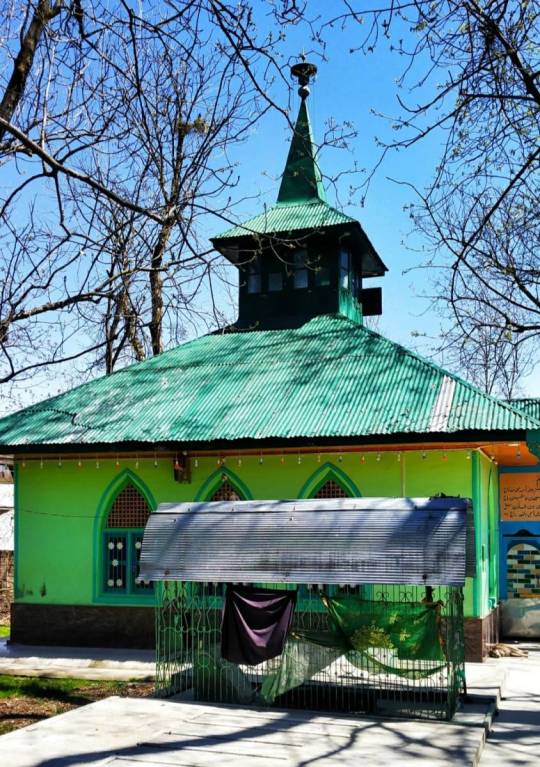
View On WordPress
#biography of great personalities#dargahs of kashmir#great sufi saints#hidden saints of india#hidden Sufis of kashmir#kashmiri spiritual circle#kashmiri sufi music#kashmiri Sufism articles#learn about islam in kashmir#spiritual orders in kashmir#sufis of kashmir#Sufis of kashmir blog#sufis of kupwara#what is kashmiri mysticism
0 notes